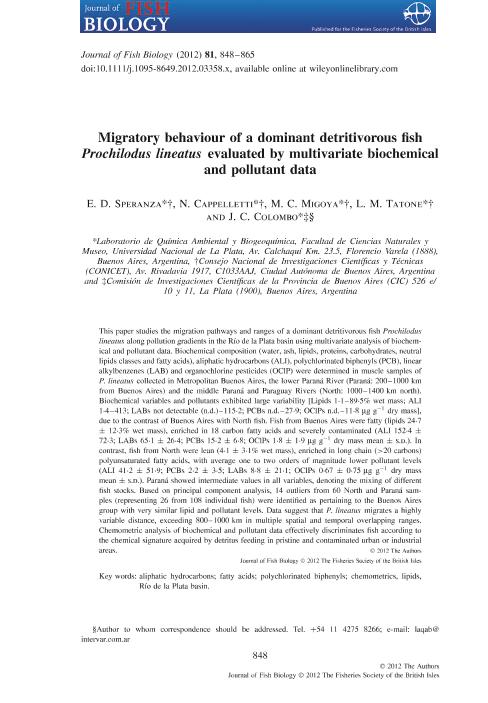Artículo
Migratory behaviour of a dominant detritivorous fish Prochilodus lineatus evaluated by multivariate biochemical and pollutant data
Fecha de publicación:
07/2012
Editorial:
Wiley Blackwell Publishing, Inc
Revista:
Journal of Fish Biology
ISSN:
0022-1112
Idioma:
Inglés
Tipo de recurso:
Artículo publicado
Clasificación temática:
Resumen
This paper studies the migration pathways and ranges of a dominant detritivorous fish Prochilodus lineatus along pollution gradients in the Río de la Plata basin using multivariate analysis of biochemical and pollutant data. Biochemical composition (water, ash, lipids, proteins, carbohydrates, neutral lipids classes and fatty acids), aliphatic hydrocarbons (ALI), polychlorinated biphenyls (PCB), linear alkylbenzenes (LAB) and organochlorine pesticides (OClP) were determined in muscle samples of P. lineatus collected in Metropolitan Buenos Aires, the lower Paraná River (Paraná: 200-1000 km from Buenos Aires) and the middle Paraná and Paraguay Rivers (North: 1000-1400 km north). Biochemical variables and pollutants exhibited large variability [Lipids 1·1-89·5% wet mass; ALI 1·4-413; LABs not detectable (n.d.)-115·2; PCBs n.d.-27·9; OClPs n.d.-11·8 μg g-1 dry mass], due to the contrast of Buenos Aires with North fish. Fish from Buenos Aires were fatty (lipids 24·7 ± 12·3% wet mass), enriched in 18 carbon fatty acids and severely contaminated (ALI 152·4 ± 72·3; LABs 65·1 ± 26·4; PCBs 15·2 ± 6·8; OClPs 1·8 ± 1·9 μg g-1 dry mass mean ±s.d.). In contrast, fish from North were lean (4·1 ± 3·1% wet mass), enriched in long chain (>20 carbons) polyunsaturated fatty acids, with average one to two orders of magnitude lower pollutant levels (ALI 41·2 ± 51·9; PCBs 2·2 ± 3·5; LABs 8·8 ± 21·1; OClPs 0·67 ± 0·75 μg g-1 dry mass mean ±s.d.). Paraná showed intermediate values in all variables, denoting the mixing of different fish stocks. Based on principal component analysis, 14 outliers from 60 North and Paraná samples (representing 26 from 108 individual fish) were identified as pertaining to the Buenos Aires group with very similar lipid and pollutant levels. Data suggest that P. lineatus migrates a highly variable distance, exceeding 800-1000 km in multiple spatial and temporal overlapping ranges. Chemometric analysis of biochemical and pollutant data effectively discriminates fish according to the chemical signature acquired by detritus feeding in pristine and contaminated urban or industrial areas.
Archivos asociados
Licencia
Identificadores
Colecciones
Articulos(CCT - LA PLATA)
Articulos de CTRO.CIENTIFICO TECNOL.CONICET - LA PLATA
Articulos de CTRO.CIENTIFICO TECNOL.CONICET - LA PLATA
Citación
Speranza, Eric Demian; Cappelletti, Natalia Elsa; Migoya, Maria Carolina; Tatone, Leandro Martín; Migratory behaviour of a dominant detritivorous fish Prochilodus lineatus evaluated by multivariate biochemical and pollutant data; Wiley Blackwell Publishing, Inc; Journal of Fish Biology; 81; 2; 7-2012; 848-865
Compartir
Altmétricas




